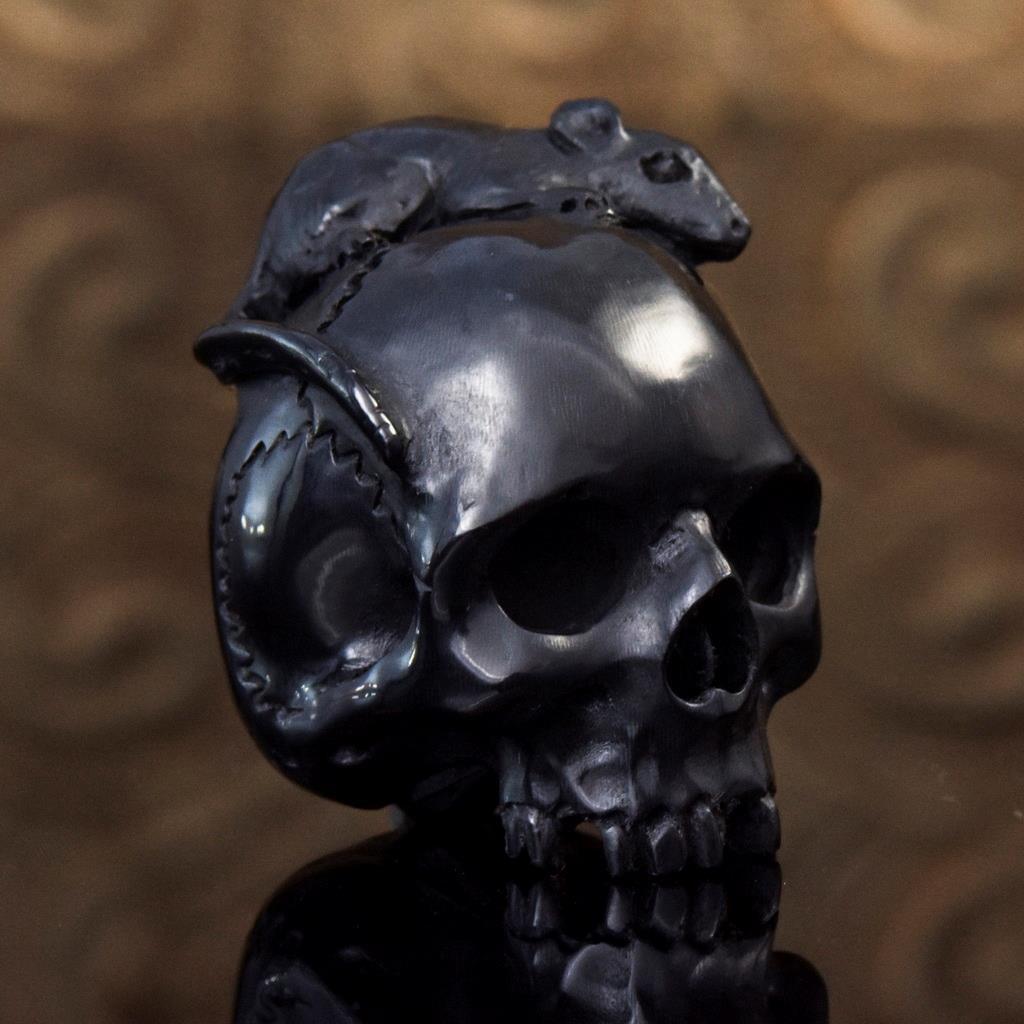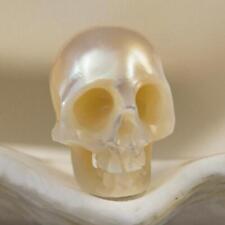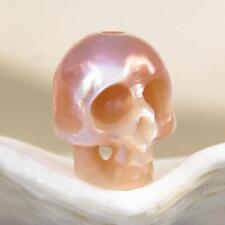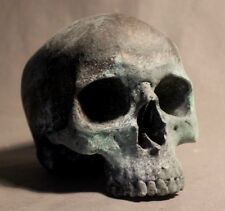Human Skull & Rat Horn Carving Memento Mori Sculpture Netsuke Figurine 16.94 g For Sale

When you click on links to various merchants on this site and make a purchase, this can result in this site earning a commission. Affiliate programs and affiliations include, but are not limited to, the eBay Partner Network.
Human Skull & Rat Horn Carving Memento Mori Sculpture Netsuke Figurine 16.94 g:
$58.00
a.imagelink {color:#0000FF;} a:hover.imagelink {color:#0000FF;} a:visited.imagelink {color:#800080;} a.imagelink img.saleimage { border: 2px solid #0000FF; } a:visited.imagelink img.saleimage { border: 2px solid #800080; }
Item # : 390 1598
Type : Black bovine buffalo horn bead / art carving Memento Mori sculpture “Netsuke style”
Design : Carving of a HUMAN SKULL with RAT ~ extremely fine detail / without lower jaw
Material : Natural black bovine buffalo horn
Amount : 1 (one) single piece
* All photos are taken from the actual item *
Weight : approx. 16.94 grams
Size : Height: approx. 41.10 mm = 1.61 inches
Width: approx. 25.85 mm
Depth: approx. 31.63 mm
All measurements are taken at the widest points
Perforation : This skull is not drilled.
Color : Black
Origin : Hand-carved by Balinese master-craftsmen
Quality : New and excellent
Treatment : 100 % natural buffalo horn which is hand-carved and polished
Definition Memento Mori : Memento Mori ~ European Reminder of Mortality
The thought came into its own with Christianity, whose strong emphasis on Divine Judgment, heaven, hell, and the salvation of the soul brought death to the forefront of consciousness. Most memento mori works are products of Christian art, although there are equivalents in Buddhist art. In the Christian context, the memento mori acquires a moralizing purpose quite opposed to the Nunc est bibendum theme of Classical antiquity. To the Christian, the prospect of death serves to emphasize the emptiness and fleetingness of earthly pleasures, luxuries, and achievements, and thus also as an invitation to focus one's thoughts on the prospect of the afterlife. A Biblical injunction often associated with the memento mori in this context is In omnibus operibus tuis memorare novissima tua, et in aeternum non peccabis (the Vulgate's Latin rendering of Ecclesiasticus 7:40, "in all thy works be mindful of thy last end and thou wilt never sin.") This finds ritual expression in the rites of Ash Wednesday, when ashes are placed upon the worshipers' heads with the words "Remember Man that you are dust and unto dust you shall return."
Prince of Orange René de Châlons died in 1544 at age 25. His widow commissioned sculptor Ligier Richier to represent him offering his heart to God, set against the painted splendor of his former worldly estate. Church of Saint-Étienne, Bar-le-Duc.
The most obvious places to look for memento mori meditations are in funeral art and architecture. Perhaps the most striking to contemporary minds is the transi, or cadaver tomb, a tomb that depicts the decayed corpse of the deceased. This became a fashion in the tombs of the wealthy in the fifteenth century, and surviving examples still create a stark reminder of the vanity of earthly riches. Later, Puritan tomb stones in the colonial United States frequently depicted winged skulls, skeletons, or angels snuffing out candles. These are among the numerous themes associated with skull imagery.
Another example of memento mori is provided by the chapels of bones, such as the Capela dos Ossos in Évora or the Capuchin Crypt in Rome. These are chapels where the walls are totally or partially covered by human remains, mostly bones. The entrance to the former has the sentence "We bones, lying here bare, wait for yours."
The famous danse macabre, with its dancing depiction of the Grim Reaper carrying off rich and poor alike, is another well-known example of the memento mori theme. This and similar depictions of Death decorated many European churches.
Timepieces were formerly an apt reminder that your time on Earth grows shorter with each passing minute. Public clocks would be decorated with mottos such as ultima forsan ("perhaps the last" [hour]) or vulnerant omnes, ultima necat ("they all wound, and the last kills"). Even today, clocks often carry the motto tempus fugit, "time flees". Old striking clocks often sported automata who would appear and strike the hour; some of the celebrated automaton clocks from Augsburg, Germany, had Death striking the hour. The several computerized "death clocks" revive this old idea. Private people carried smaller reminders of their own mortality. Mary, Queen of Scots, owned a large watch carved in the form of a silver skull, embellished with the lines of Horace.
A version of the theme in the artistic genre of still life is more often referred to as a vanitas, Latin for "vanity". These include symbols of mortality, whether obvious ones like skulls, or subtler ones, like a flower losing its petals. See the themes associated with the image of the skull.
After the invention of photography, many people had photographs taken of recently dead family members. Given the technical limitations of daguerreotype photography which required long exposure times, this was one situation where the portrait subject remained quite still.
Memento mori was also an important literary theme. Well-known literary meditations on death in English prose include Sir Thomas Browne's Hydriotaphia, Urn Burial and Jeremy Taylor's Holy Living and Holy Dying. These works were part of a Jacobean cult of melancholia that marked the end of the Elizabethan era. In the late eighteenth century, literary elegies were a common genre; Thomas Gray's Elegy Written in a Country Churchyard and Edward Young's Night Thoughts are typical members of the genre.
Apart from the genre of requiem and funeral music, there is also a rich tradition of memento mori in the Early Music of Europe. Especially those facing the ever-present death during the recurring bubonic plague pandemics from the 1340s onward tried to toughen themselves by anticipating the inevitable in chants, from the simple Geisslerlieder of the Flagellant movement to the more refined cloistral or courtly songs. The lyrics often looked at life as a necessary and god-given vale of tears with death as a ransom and reminded people to lead sinless lives to stand a chance at Judgement Day. Two stanzas typical of memento mori in mediaeval music are from the virelai ad mortem festinamus of the Catalan Llibre Vermell de Montserrat from 1399:
Vita brevis breviter in brevi finietur,
Mors venit velociter quae neminem veretur,
Omnia mors perimit et nulli miseretur.
Ad mortem festinamus peccare desistamus.
Life is short, and shortly it will end;
Death comes quickly and respects no one,
Death destroys everything and takes pity on no one.
To death we are hastening, let us refrain from sinning.
Ni conversus fueris et sicut puer factus
Et vitam mutaveris in meliores actus,
Intrare non poteris regnum Dei beatus.
Ad mortem festinamus peccare desistamus.
If you do not turn back and become like a child,
And change your life for the better,
You will not be able to enter, blessed, the Kingdom of God.
To death we are hastening, let us refrain from sinning.
Buffalo horn : WATER BUFFALO HORN (Bovine)
LATIN NAME: Bubalus bubalis
ORIGIN: South East Asia
HARVESTING PRACTICE: The horn we use is a by-product of meat production and farming practice.
OTHER DETAILS: Recycled. The water buffalo of South East Asia is a domesticated animal. It is used to plow fields and carry loads. They are well treated and important to the survival of the native people. When they are too old to work, they are eaten and all parts of the animal are utilized. They are never taken in pursuit of the horns!
OUR SOURCE: Ours comes from the Island of Lombok, Sulawesi and Sumbawa, Indonesia.
ABOUT THE HORN AND ITS CARE: Horn is very much like your hair or fingernails in nature, and requires care! Take care to protect it from harsh elements and not to drop it or sit or step on it! The horn needs to be conditioned, and should be oiled to protect it with jojoba oil, coconut oil or some other organic jewelry care product. This will maintain the color and preserve the smooth surface. Organic horn should never be left in water or direct sunlight (like the bathroom sink or the dashboard of your car). Do not soak or autoclave any of our organic materials.
Organic, biodegradable materials should be treated with care and respect.
Our mission!
Our adornments are hand-crafted by traditional people of natural materials which were harvested in an environmentally responsible way. All our organic products are crafted, one piece at a time. We strive to provide quality, unique, handmade earth-friendly products to satisfy the soul and beyond …
By purchasing our organic products, you are supporting traditional crafts and culture, while improving the quality of lives in local communities. We provide jobs where there may otherwise be none. We work directly with the craftspeople to create our original designs in Buffalo Horn.
We stand behind the quality of our product and the aesthetic of its design.
… ENJOY YOUR EXOTIC NATURE …
By choosing our organic products you are not contributing to the environmental hazards and degradation of natural land.
No materials are wasted in our production process. All are biodegradable. Any horn scraps are composted in the garden.
Our organic raw materials are responsibly harvested
Remarks : Don’t miss this opportunity to own this beautiful handcrafted piece of art for your collection
Our photographs have been enlarged to show details. Most details shown in the large image are actually not visible to the naked eye. We have made the image as close as possible to the original item when viewed on our screen. Depending on the viewers monitor settings, these items may appear a few shades lighter or darker in comparison to the original object. Why Shop with AGUSTUS-Collection
» Seller since the Year 2000
» Very high Approval Rating
» Outstanding Collection
» Custom Orders & Wholesale
» Free Shipping for purchases over US$ 500
» Combine Shipping for 10 days
» Secure Packing & Shipping Services
» Secure Payment
» Items are guaranteed as described
» Clear Return Policy
» Fast Support Response
» Outstanding Customer Service
Auctiva offers Free Image Hosting and Editing.
The complete Selling Solution.

Related Items:
8.78 mm Human Skull Carving Cream Freshwater Pearl 0.46 g vertically drilled
$29.00
7.73mm Human Skull Carved Pink Peach Freshwater Pearl 0.30g vertically drilled
$29.00
Human Skull Anatomical Medical Death Oddity Theater Doctor Funeral Postmortem
$125.00



